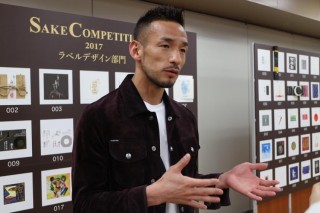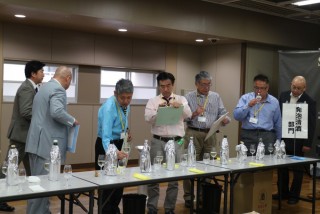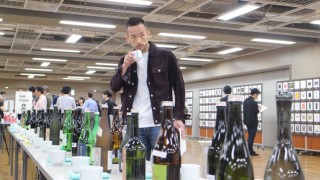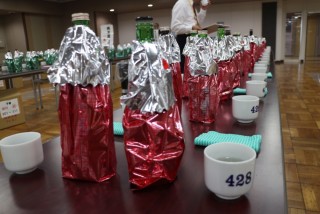Loading
Search
▼ Soccer Atar Nakata Plays Host to World’s Biggest Sake Competition
- Category:Event
TOKYO - “I believe that the sake industry can become like the wine industry,” contends Hidetoshi Nakata, speaking about his vision for the future of a drink that, despite a steady decline in domestic sales, remains synonymous with his home country.
The genial soccer star-turned-sake ambassador is the host of the Sake Competition 2017, an annual contest that aims to set the benchmark for brand quality and raise the profile of the drink both at home and abroad.
The judging took place at the Tokyo Metropolitan Industrial Trade Center in Asakusa last week. It was a fitting setting, given the area’s Edo-period reputation for being the liveliest (read: drunkest) neighborhood in the capital. It’s still a fantastic place to meet, drink and be merry and, although serious, there was a sense of conviviality in the air as Nakata and the select panel of judges moved around the room, sampling the various sakes for round one of the two-day contest.
The genial soccer star-turned-sake ambassador is the host of the Sake Competition 2017, an annual contest that aims to set the benchmark for brand quality and raise the profile of the drink both at home and abroad.
The judging took place at the Tokyo Metropolitan Industrial Trade Center in Asakusa last week. It was a fitting setting, given the area’s Edo-period reputation for being the liveliest (read: drunkest) neighborhood in the capital. It’s still a fantastic place to meet, drink and be merry and, although serious, there was a sense of conviviality in the air as Nakata and the select panel of judges moved around the room, sampling the various sakes for round one of the two-day contest.
A mixture of Japanese and foreign judges were given the challenging task of evaluating 1,729 entries from 453 breweries — the highest number of participants in the competition’s six-year history, making it the largest sake competition in the world.
Unlike many other sake competitions, however, every bottle tried and tested over the competition is available for consumer purchase. It’s part of Nakata’s ambition to make sake more accessible to the public, who often have misconceptions about the variety and availability of sake.
“Even many Japanese people know less than 10 brands of sake. But actually there are more than 4 or 5,000 brands out there,” he says — a number which includes his own exclusive sake brand “N”, produced specifically to generate interest in sake abroad.
Unlike many other sake competitions, however, every bottle tried and tested over the competition is available for consumer purchase. It’s part of Nakata’s ambition to make sake more accessible to the public, who often have misconceptions about the variety and availability of sake.
“Even many Japanese people know less than 10 brands of sake. But actually there are more than 4 or 5,000 brands out there,” he says — a number which includes his own exclusive sake brand “N”, produced specifically to generate interest in sake abroad.
“We want to educate people and give them the power to make choices when they’re drinking sake,” he says. “Just like how people order wine by the name in a restaurant, they should be able to do the same with sake [...], not just order ‘hot’ or ‘cold,’ ‘dry’ or ‘sweet.’”
I have to admit that these four options are about as far as my own knowledge of sake extends, whereas when it comes to wine, I’d be much more adept at choosing a decent bottle.
Nakata, along with the competition’s organizing committee led by sake retailer Hasegawa Saketen, hopes to reveal the potential of sake to uninformed people just like myself. A key selling point of sake, he points out, is its versatility when it comes to pairing it with food, not only Japanese.
“Just like Japanese restaurants serve wine, beer, and champagne, international restaurants should serve it — it can go with French cuisine, Italian cuisine, so why not?”
While the popularity of sake in Japan continues to trail in the wake of a booming craft beer scene, exports of the drink overseas have shot up in the past decade, in particular to the U.S., which accounts for about 25% of the total exports, according to government figures. Countries elsewhere in Asia, such as Hong Kong and Taiwan, are showing increasing interest, with China emerging as the fastest-growing market.
The trend goes hand in hand with the recent hype around Japanese food. If Japan can compete with France in the culinary reverence stakes (only these two countries’ cuisines have been added to the United Nations’ cultural heritage list, while Japan beats France in the number of Michelin-starred restaurants), then why not in terms of its national beverage?
Still, many breweries in Japan struggle to take full advantage of the opportunities brought about by growing enthusiasm overseas. Bound by centuries of brewing heritage, as well as complicated regulations regarding licensing and distribution, sake makers are unsure how to navigate this new market.
Marketing sake faces many challenges
For Nakata, part of the reason that the Sake Competition was created six years ago was to address exactly these issues. Having spent seven years traveling around each of Japan’s 47 prefectures and meeting face to face with various sake producers, he understands personally some of the challenges that they’re up against.
“This competition is not all about saying ‘Oh, this [sake] is the best one, or this is not a good one.’ It’s more like we want to educate both sides: the market [consumers] and the brewers. It’s like a bridge,” he explains.
Brewers were able to submit their entries for judging among seven categories. This year, following on from the introduction of the “Super Premium” division in 2016 for emerging high-end labels, two more categories have been added under Nakata’s supervision. Significantly, these categories were introduced to educate sake producers about branding, as well as how to appeal to a broader market.
I have to admit that these four options are about as far as my own knowledge of sake extends, whereas when it comes to wine, I’d be much more adept at choosing a decent bottle.
Nakata, along with the competition’s organizing committee led by sake retailer Hasegawa Saketen, hopes to reveal the potential of sake to uninformed people just like myself. A key selling point of sake, he points out, is its versatility when it comes to pairing it with food, not only Japanese.
“Just like Japanese restaurants serve wine, beer, and champagne, international restaurants should serve it — it can go with French cuisine, Italian cuisine, so why not?”
While the popularity of sake in Japan continues to trail in the wake of a booming craft beer scene, exports of the drink overseas have shot up in the past decade, in particular to the U.S., which accounts for about 25% of the total exports, according to government figures. Countries elsewhere in Asia, such as Hong Kong and Taiwan, are showing increasing interest, with China emerging as the fastest-growing market.
The trend goes hand in hand with the recent hype around Japanese food. If Japan can compete with France in the culinary reverence stakes (only these two countries’ cuisines have been added to the United Nations’ cultural heritage list, while Japan beats France in the number of Michelin-starred restaurants), then why not in terms of its national beverage?
Still, many breweries in Japan struggle to take full advantage of the opportunities brought about by growing enthusiasm overseas. Bound by centuries of brewing heritage, as well as complicated regulations regarding licensing and distribution, sake makers are unsure how to navigate this new market.
Marketing sake faces many challenges
For Nakata, part of the reason that the Sake Competition was created six years ago was to address exactly these issues. Having spent seven years traveling around each of Japan’s 47 prefectures and meeting face to face with various sake producers, he understands personally some of the challenges that they’re up against.
“This competition is not all about saying ‘Oh, this [sake] is the best one, or this is not a good one.’ It’s more like we want to educate both sides: the market [consumers] and the brewers. It’s like a bridge,” he explains.
Brewers were able to submit their entries for judging among seven categories. This year, following on from the introduction of the “Super Premium” division in 2016 for emerging high-end labels, two more categories have been added under Nakata’s supervision. Significantly, these categories were introduced to educate sake producers about branding, as well as how to appeal to a broader market.
The “Label Design” category enables breweries to submit their innovative labels for assessment by three brand design experts, including the man behind Kumamon, the wildly successful mascot for Kumamoto
Prefecture. The “Sparkling Sake” category reflects the rising popularity of the fizzy varieties of sake, such as Mio, sold in chic blue bottles at convenience stores and a big hit with young women.
“By doing this competition, producers can understand how important the design is to help people understand the brand. It’s important for people to be able to read the bottle and remember the brand,” Nakata says.
Looking at the labels on display, it’s interesting to see the sheer diversity of design. One label with a colorful anime geisha design caught my eye and seemed unlike anything you’d normally associate with a sake bottle. In fact, it seemed like just the kind of label that would make me buy it in a store or choose it in a restaurant.
I’ll have to wait until Monday, June 5, to find out if it wins, when the official awards ceremony takes place at the Grand Hyatt Roppongi. Last year’s first-prize winning bottle sold out within hours of receiving the award, so sake producers will surely be keeping their fingers crossed for a good result.
But in the end it’s not all about winning, says Nakata.
“People need something to follow, to be a part of,” he says. “We want to say to breweries: ‘You have a chance, you have a dream, you should seize it.”
Find out who won world’s best sake at the Sake Competition Awards Ceremony
The final results of judging will be announced at the official awards ceremony which will take place on Friday 5th June at the Grand Hyatt hotel in Roppongi. The prize-giving will be followed by an exclusive after party where guests can sample the various types of sake entered into the contest.
Get your tickets here.
Details
Date: June 5
Venue: Grand Ballroom, Grand Hyatt Tokyo
Time: Awards Ceremony from 13:00 / Prize Ceremony from 18:30
Tickets: ¥33,000 for awards ceremony and after party (¥30,000 for after party only)
© Japan Today
Prefecture. The “Sparkling Sake” category reflects the rising popularity of the fizzy varieties of sake, such as Mio, sold in chic blue bottles at convenience stores and a big hit with young women.
“By doing this competition, producers can understand how important the design is to help people understand the brand. It’s important for people to be able to read the bottle and remember the brand,” Nakata says.
Looking at the labels on display, it’s interesting to see the sheer diversity of design. One label with a colorful anime geisha design caught my eye and seemed unlike anything you’d normally associate with a sake bottle. In fact, it seemed like just the kind of label that would make me buy it in a store or choose it in a restaurant.
I’ll have to wait until Monday, June 5, to find out if it wins, when the official awards ceremony takes place at the Grand Hyatt Roppongi. Last year’s first-prize winning bottle sold out within hours of receiving the award, so sake producers will surely be keeping their fingers crossed for a good result.
But in the end it’s not all about winning, says Nakata.
“People need something to follow, to be a part of,” he says. “We want to say to breweries: ‘You have a chance, you have a dream, you should seize it.”
Find out who won world’s best sake at the Sake Competition Awards Ceremony
The final results of judging will be announced at the official awards ceremony which will take place on Friday 5th June at the Grand Hyatt hotel in Roppongi. The prize-giving will be followed by an exclusive after party where guests can sample the various types of sake entered into the contest.
Get your tickets here.
Details
Date: June 5
Venue: Grand Ballroom, Grand Hyatt Tokyo
Time: Awards Ceremony from 13:00 / Prize Ceremony from 18:30
Tickets: ¥33,000 for awards ceremony and after party (¥30,000 for after party only)
© Japan Today
- June 3, 2017
- Comment (0)
- Trackback(0)





